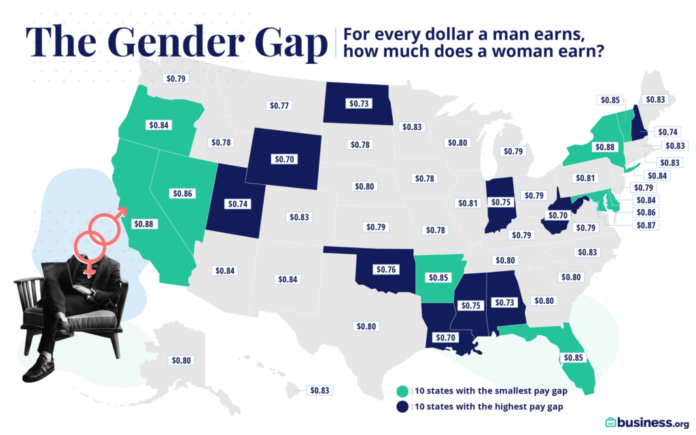The gender pay gap in the United States remains a contentious and multifaceted issue, reflecting deep-seated societal disparities and systemic inequities. Although significant strides have been made toward gender equality, women, on average, continue to earn less than men across nearly every industry and occupation. This disparity has profound implications not only for the economic well-being of women but also for families, communities, and the broader economy itself. Understanding why the gender pay gap persists requires a nuanced examination of various intersecting factors, including occupational segregation, disparities in work experience and education, and cultural expectations and discrimination.
In order to address the persistence of the gender pay gap, it is crucial to scrutinize the structural impediments that contribute to this inequity. While policies to promote equal pay for equal work have been put in place, the gap persists largely due to the cumulative disadvantages women face throughout their careers. This article seeks to illuminate the key reasons behind the enduring disparity in wages between genders in the United States.
To foster a comprehensive understanding of this issue, it is essential to examine the following areas:
- Occupational Segregation: The Division of Labor
- Experience and Education: A Double-Edged Sword
- Cultural Norms and Perceptions: The Unseen Barriers
Occupational Segregation: The Division of Labor
One of the principal factors contributing to the gender pay gap is occupational segregation, which refers to the disproportionate representation of men and women in different professions and industries. Traditionally, jobs categorized as “women’s work”—such as teaching, nursing, and administrative roles—tend to pay significantly less than those predominantly held by men, such as engineering, technology, and finance. This division of labor perpetuates economic disparities, as it reflects societal values regarding gender roles and the worth assigned to various professions.
Moreover, the segmentation of the labor market discourages women from entering high-paying fields. For instance, women are underrepresented in STEM (Science, Technology, Engineering, and Mathematics) fields, which offer lucrative career opportunities. Barriers to entry, including lack of encouragement, stereotypes regarding women’s abilities in technical domains, and inadequate access to resources, contribute to this disparity. This phenomenon not only deprives women of the chance to earn higher wages, but it also perpetuates the cycle of economic inequality across generations.
Additionally, the pay gap is exacerbated by the prevalence of part-time work among women, many of whom take on part-time roles in an effort to balance professional aspirations with familial responsibilities. Part-time positions often come with reduced benefits and lower hourly wages, further contributing to the income disparity. In this respect, the systemic structures that govern workplace practices and policies disadvantage women, making it difficult for them to achieve equitable compensation.
Experience and Education: A Double-Edged Sword
While the level of education among women has increased dramatically over the past few decades, this has not necessarily translated into equal pay. Women now earn more college degrees than men, yet they still face disparities in compensation in the labor market. This paradox can be attributed to several factors, including the undervaluing of “female-dominated” fields of study and the impact of work experience on wage potential.
Even in sectors where women are well-represented, pay tends to be lower than in male-dominated fields. For instance, degrees in education and social sciences—fields favored by many women—command lower salaries compared to degrees in engineering or finance. This divergence highlights the pervasive issue of value attribution within education and employment, revealing implicit biases that favor certain professions over others.
Another contributing factor is the experience gap between men and women. Men often have more continuous and uninterrupted career trajectories than women, who may take time off for childcare or caregiving responsibilities. Even when women return to the workforce, they may find themselves at a disadvantage due to gaps in experience, leading to lower starting salaries and stunted advancement in their careers.
Furthermore, negotiation skills and confidence also play a significant role in compensation outcomes. Studies have shown that women are less likely than men to negotiate their salaries, often due to societal conditioning that discourages assertiveness in women. This reluctance can result in initial offers that are lower and a failure to advocate for pay increases, effectively compounding the disparity over time.
Cultural Norms and Perceptions: The Unseen Barriers
The influence of cultural norms and societal perceptions cannot be understated when discussing the gender pay gap. From an early age, societal expectations instill in individuals specific beliefs about gender roles and appropriate career paths. These cultural stereotypes can affect women’s career choices, aspirations, and perceptions of their own value in the workplace.
Discrimination, both overt and subtle, continues to pervade various sectors of the economy. Implicit biases often affect hiring, promotions, and pay decisions. Women may face skepticism about their capabilities, especially in leadership roles or traditionally male-dominated professions. Furthermore, research illustrates that women are often judged more harshly than men for similar behaviors in the workplace, resulting in a double standard that complicates their career advancement.
Moreover, the emphasis placed on work-life balance, while beneficial, may also inadvertently reinforce gender disparities. Women frequently shoulder a disproportionate burden of household responsibilities and caregiving, leading to a conflict between professional ambitions and personal obligations. Employers’ expectations surrounding workplace presence and commitment often do not accommodate these realities, potentially capping women’s earning potential.
In conclusion, the gender pay gap in the United States is a complex and multi-faceted issue that persists due to a confluence of factors including occupational segregation, disparities in experience and education, as well as cultural norms and discrimination. Acknowledging these structural barriers is imperative for creating meaningful change toward achieving wage equity. Initiatives that cultivate broader access to education in high-paying fields, promote work-life balance, and mitigate biases in hiring practices could pave the way for a more equitable future. Only through concerted effort and systemic change can society bridge the persistent divide in pay and ensure fairness for all individuals, regardless of gender, in the workforce.





























